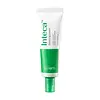What's inside
What's inside
 Key Ingredients
Key Ingredients

 Benefits
Benefits

 Concerns
Concerns

 Ingredients Side-by-side
Ingredients Side-by-side

Water
Skin ConditioningPropanediol
SolventGlycerin
HumectantGlyceryl Glucoside
Humectant1,2-Hexanediol
Skin ConditioningCaprylic/Capric Triglyceride
MaskingHydrogenated Polydecene
EmollientNiacinamide
SmoothingButylene Glycol
HumectantSorbitol
HumectantCetearyl Olivate
Vinyldimethicone
Sorbitan Olivate
EmulsifyingCarbomer
Emulsion StabilisingCandida Bombicola/Glucose/Methyl Rapeseedate Ferment
AntimicrobialHelianthus Annuus Seed Oil
EmollientAsiaticoside
AntioxidantAsiatic Acid
Skin ConditioningMadecassic Acid
Skin ConditioningHyaluronic Acid
HumectantHydrolyzed Hyaluronic Acid
HumectantSodium Hyaluronate
HumectantDipropylene Glycol
HumectantGlyceryl Stearate Se
EmulsifyingHydrogenated Lecithin
EmulsifyingTromethamine
BufferingEthylhexylglycerin
Skin ConditioningAdenosine
Skin ConditioningDisodium EDTA
Ethoxydiglycol
HumectantWater, Propanediol, Glycerin, Glyceryl Glucoside, 1,2-Hexanediol, Caprylic/Capric Triglyceride, Hydrogenated Polydecene, Niacinamide, Butylene Glycol, Sorbitol, Cetearyl Olivate, Vinyldimethicone, Sorbitan Olivate, Carbomer, Candida Bombicola/Glucose/Methyl Rapeseedate Ferment, Helianthus Annuus Seed Oil, Asiaticoside, Asiatic Acid, Madecassic Acid, Hyaluronic Acid, Hydrolyzed Hyaluronic Acid, Sodium Hyaluronate, Dipropylene Glycol, Glyceryl Stearate Se, Hydrogenated Lecithin, Tromethamine, Ethylhexylglycerin, Adenosine, Disodium EDTA, Ethoxydiglycol
Water
Skin ConditioningPropanediol
SolventGlycerin
HumectantAlcohol Denat.
AntimicrobialCyclopentasiloxane
EmollientHydrogenated Poly(C6-14 Olefin)
EmollientCetyl Ethylhexanoate
EmollientDimethicone
EmollientCyclohexasiloxane
EmollientGlycine Max Seed Extract
Skin ConditioningSaccharomyces Ferment Filtrate
HumectantNatto Gum
Adenosine
Skin ConditioningC14-22 Alcohols
Emulsion StabilisingSilica
AbrasiveButyrospermum Parkii Butter
Skin ConditioningHydroxyethyl Acrylate/Sodium Acryloyldimethyl Taurate Copolymer
Emulsion StabilisingGlyceryl Stearate
EmollientCarbomer
Emulsion StabilisingPEG-100 Stearate
Stearic Acid
CleansingC12-20 Alkyl Glucoside
EmulsifyingPalmitic Acid
EmollientGlyceryl Caprylate
EmollientPolysilicone-11
Ethylhexylglycerin
Skin ConditioningButylene Glycol
HumectantTromethamine
BufferingDisodium EDTA
Parfum
MaskingWater, Propanediol, Glycerin, Alcohol Denat., Cyclopentasiloxane, Hydrogenated Poly(C6-14 Olefin), Cetyl Ethylhexanoate, Dimethicone, Cyclohexasiloxane, Glycine Max Seed Extract, Saccharomyces Ferment Filtrate, Natto Gum, Adenosine, C14-22 Alcohols, Silica, Butyrospermum Parkii Butter, Hydroxyethyl Acrylate/Sodium Acryloyldimethyl Taurate Copolymer, Glyceryl Stearate, Carbomer, PEG-100 Stearate, Stearic Acid, C12-20 Alkyl Glucoside, Palmitic Acid, Glyceryl Caprylate, Polysilicone-11, Ethylhexylglycerin, Butylene Glycol, Tromethamine, Disodium EDTA, Parfum
 Reviews
Reviews

Ingredients Explained
These ingredients are found in both products.
Ingredients higher up in an ingredient list are typically present in a larger amount.
Adenosine is in every living organism. It is one of four components in nucleic acids that helps store our DNA.
Adenosine has many benefits when used. These benefits include hydrating the skin, smoothing skin, and reducing wrinkles. Once applied, adenosine increases collagen production. It also helps with improving firmness and tissue repair.
Studies have found adenosine may also help with wound healing.
In skincare products, Adenosine is usually derived from yeast.
Learn more about AdenosineButylene Glycol (or BG) is used within cosmetic products for a few different reasons:
Overall, Butylene Glycol is a safe and well-rounded ingredient that works well with other ingredients.
Though this ingredient works well with most skin types, some people with sensitive skin may experience a reaction such as allergic rashes, closed comedones, or itchiness.
Learn more about Butylene GlycolCarbomer is a polymer of acrylic acid. Its main role is to create a gel consistency.
A high amount of carbomer can cause pilling or balling up of products. Don't worry, most products contain 1% or less of carbomer.
Disodium EDTA plays a role in making products more stable by aiding other preservatives.
It is a chelating agent, meaning it neutralizes metal ions that may be found in a product.
Disodium EDTA is a salt of edetic acid and is found to be safe in cosmetic ingredients.
Learn more about Disodium EDTAEthylhexylglycerin (we can't pronounce this either) is commonly used as a preservative and skin softener. It is derived from glyceryl.
You might see Ethylhexylglycerin often paired with other preservatives such as phenoxyethanol. Ethylhexylglycerin has been found to increase the effectiveness of these other preservatives.
Glycerin is already naturally found in your skin. It helps moisturize and protect your skin.
A study from 2016 found glycerin to be more effective as a humectant than AHAs and hyaluronic acid.
As a humectant, it helps the skin stay hydrated by pulling moisture to your skin. The low molecular weight of glycerin allows it to pull moisture into the deeper layers of your skin.
Hydrated skin improves your skin barrier; Your skin barrier helps protect against irritants and bacteria.
Glycerin has also been found to have antimicrobial and antiviral properties. Due to these properties, glycerin is often used in wound and burn treatments.
In cosmetics, glycerin is usually derived from plants such as soybean or palm. However, it can also be sourced from animals, such as tallow or animal fat.
This ingredient is organic, colorless, odorless, and non-toxic.
Glycerin is the name for this ingredient in American English. British English uses Glycerol/Glycerine.
Learn more about GlycerinPropanediol is an all-star ingredient. It softens, hydrates, and smooths the skin.
It’s often used to:
Propanediol is not likely to cause sensitivity and considered safe to use. It is derived from corn or petroleum with a clear color and no scent.
Learn more about PropanediolTromethamine helps balance the pH and improve the texture of a product. It is synthetically created.
As an emulsifier, Tromethamine prevents oil and water ingredients from separating. This helps stabilize the product and elongate a product's shelf life. Tromethamine also makes a product thicker.
Tromethamine helps balance the pH level of a product. Normal pH level of skin is slightly acidic (~4.75-5.5). The acidity of our skin is maintained by our glands and skin biome. Being slightly acidic allows our skin to create an "acid mantle". This acid mantle is a thin barrier that protects our skin from bacteria and contaminants.
Oral Tromethanmine is an anti-inflammatory drug but plays the role of masking, adding fragrance, and/or balancing pH in skincare.
1,3-Propanediol, 2-amino-2-(hydroxymethyl)-
Learn more about TromethamineWater. It's the most common cosmetic ingredient of all. You'll usually see it at the top of ingredient lists, meaning that it makes up the largest part of the product.
So why is it so popular? Water most often acts as a solvent - this means that it helps dissolve other ingredients into the formulation.
You'll also recognize water as that liquid we all need to stay alive. If you see this, drink a glass of water. Stay hydrated!
Learn more about Water